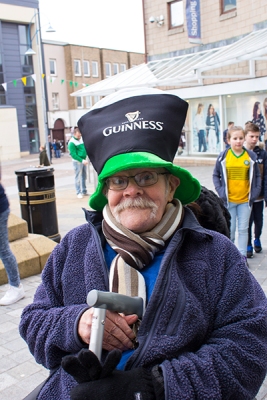Hello everybody! Today I have something special to show you. I was in Coatbridge, Scotland to see St Patrick’s Day Festival and was really happy to see all the bands playing, girls dancing and people walking in their fancy dresses. I love the Irish music and the drums, even if it was very cold today, it was worth coming to watch the bands.
Coatbridge is an urban town located on the eastern fringes of Glasgow, Scotland. The town quickly expanded during the late 18th century as a centre of iron making, in part because it had a direct canal link to Glasgow. Cheap unskilled labour was in large demand and as result the town became a popular destination for vast numbers of Irish arriving in Scotland during this period. One local historian estimates that 1,000 per week were arriving in west of Scotland at one point. Coatbridge today is well known as a working class town which has been described as “little Ireland”.
Majority of the Irish people came here during the famine period. The Great Famine (Irish: an Gorta Mór) was a period of mass starvation, disease and emigration in Ireland between 1845 and 1852. It is sometimes referred to, mostly outside Ireland, as the Irish Potato Famine because about two-fifths of the population was solely reliant on this cheap crop for a number of historical reasons.
During the famine approximately 1 million people died and a million more emigrated from Ireland, causing the island’s population to fall by between 20% and 25%.
Coatbridge is especially noted for its historical links with Ireland. This is largely due to large scale immigration into the town from Ulster (especially from County Donegal) in the 19th century and throughout most of the 20th century. Indeed, the town has been called ‘little Ireland’.
The most obvious manifestation of these links can be seen in the annual St. Patrick’s Day Festival.
The festival is sponsored by the Irish Government and Guinness. The festival runs for over a fortnight and includes lectures, film shows, dance/Gaelic football competitions and music performances. The festival is the largest Irish celebration in Scotland. I hope you like it. Bear with me I will upload more videos and photos for you to see. If you ever happen to be in Coatrbridge at this time of the year, remember about the Festival as it is a very interesting event to watch and take part.
Saint Patrick’s Day, or the Feast of Saint Patrick (Irish: Lá Fhéile Pádraig, “the Day of the Festival of Patrick”), is a cultural and religious celebration held on 17 March, the traditional death date of Saint Patrick (c. AD 385–461), the foremost patron saint of Ireland.
Saint Patrick’s Day was made an official Christian feast day in the early 17th century and is observed by the Catholic Church, the Anglican Communion (especially the Church of Ireland), the Eastern Orthodox Church, and Lutheran Church. The day commemorates Saint Patrick and the arrival of Christianity in Ireland, as well as celebrating theheritage and culture of the Irish in general. Celebrations generally involve public parades and festivals, céilithe, and the wearing of green attire or shamrocks. Christians also attend church services and the Lenten restrictions on eating and drinking alcohol are lifted for the day, which has encouraged and propagated the holiday’s tradition of alcohol consumption.
——————————————————————————————————————–
Saint Patrick’s Day is a public holiday in the Republic of Ireland, Northern Ireland, the Canadian province ofNewfoundland and Labrador, and the British Overseas Territory of Montserrat. It is also widely celebrated by the Irish diaspora around the world, especially in Great Britain, Canada, the United States, Argentina, Australia and New Zealand.
Saint Patrick’s Day, or the Feast of Saint Patrick (Irish: Lá Fhéile Pádraig, “the Day of the Festival of Patrick”), is a cultural and religious celebration held on 17 March, the traditional death date of Saint Patrick (c. AD 385–461), the foremost patron saint of Ireland.
Saint Patrick’s Day was made an official Christian feast day in the early 17th century and is observed by the Catholic Church, the Anglican Communion (especially the Church of Ireland), the Eastern Orthodox Church, and Lutheran Church. The day commemorates Saint Patrick and the arrival of Christianity in Ireland, as well as celebrating theheritage and culture of the Irish in general. Celebrations generally involve public parades and festivals, céilithe, and the wearing of green attire or shamrocks. Christians also attend church services and the Lenten restrictions on eating and drinking alcohol are lifted for the day, which has encouraged and propagated the holiday’s tradition of alcohol consumption.
Saint Patrick’s Day is a public holiday in the Republic of Ireland, Northern Ireland, the Canadian province ofNewfoundland and Labrador, and the British Overseas Territory of Montserrat. It is also widely celebrated by the Irish diaspora around the world, especially in Great Britain, Canada, the United States, Argentina, Australia and New Zealand.
More of Irish tradition, Irish dance.



